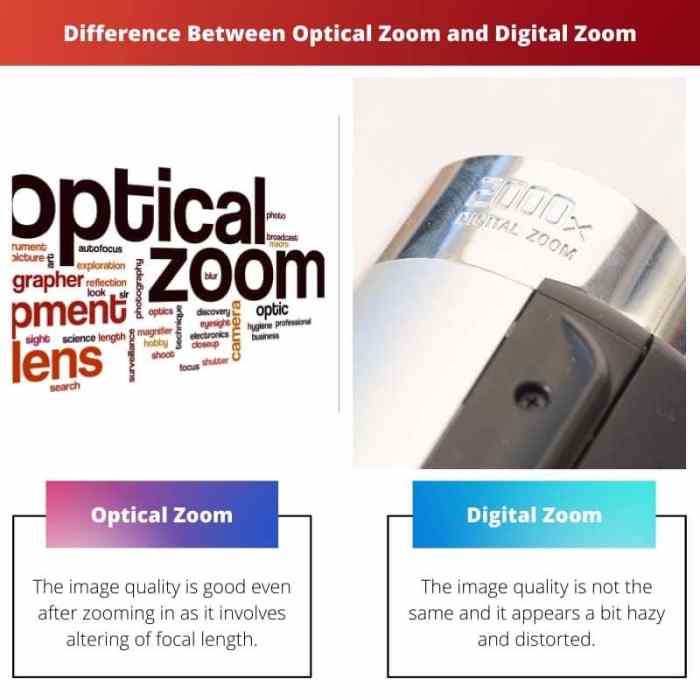Comparing optical zoom vs digital zoom in phone cameras reveals a fascinating dichotomy in smartphone photography. While both aim to magnify subjects, their underlying mechanisms and resulting image quality differ significantly. Optical zoom uses physical lens movement to achieve magnification, preserving image detail and sharpness. Digital zoom, conversely, crops and enlarges a portion of the sensor’s image, often leading to a loss of resolution and increased digital noise. This exploration delves into the intricacies of each method, examining their strengths, weaknesses, and practical applications.
Understanding these differences is crucial for any smartphone photographer aiming to capture high-quality images. This article will analyze the impact of sensor size, lens construction, and computational photography on both zoom types, ultimately helping you make informed decisions about when to use each technique. We’ll also explore the cost implications and future trends in smartphone zoom technology, providing a comprehensive overview of this important aspect of mobile photography.
The Limits of Optical and Digital Zoom

Both optical and digital zoom offer ways to magnify subjects in a photograph, but their underlying mechanisms and resulting image quality differ significantly. Understanding their limitations is crucial for choosing the right approach depending on the photographic situation and desired outcome. While optical zoom provides superior image quality, it has physical limitations; digital zoom, conversely, is limited by its inherent impact on image resolution and detail.
Optical zoom uses physical lenses to magnify the image. Digital zoom, however, crops a portion of the sensor’s image and then enlarges it. This fundamental difference leads to distinct limitations in both approaches.
Optical Zoom Limitations
Optical zoom’s limitations primarily stem from the physical constraints of lens design and manufacturing. The maximum magnification achievable is determined by the lens’s focal length range and the size of the camera’s sensor. Increasing magnification usually requires larger and more complex lens systems, leading to bulkier and more expensive devices. Furthermore, optical zoom lenses often exhibit limitations in terms of light gathering ability at higher magnifications, leading to reduced image brightness and increased susceptibility to image noise, particularly in low-light conditions. For instance, a smartphone with a 3x optical zoom might struggle to capture a clear image of a distant bird in dim light, even with image stabilization technology. The physical size and weight of the lens assembly also restrict the extent to which optical zoom can be implemented in compact devices like smartphones.
Digital Zoom Limitations
Digital zoom’s primary limitation is its impact on image resolution and quality. Since it essentially crops and enlarges a portion of the original image, it does not add any new information. The resulting image appears pixelated and lacks detail, exhibiting a significant loss of sharpness and clarity compared to the original image. This degradation becomes more pronounced as the zoom level increases. For example, using a 10x digital zoom on a smartphone with a 12-megapixel sensor will drastically reduce the effective resolution, leading to a blurry, grainy image that is unsuitable for printing or large-scale viewing. Digital zoom is essentially an artificial magnification that deteriorates the image, unlike optical zoom which gathers more light to achieve magnification.
Real-World Comparisons of Zoom Limits, Comparing optical zoom vs digital zoom in phone cameras
In real-world scenarios, the practical limits of both zoom types become apparent. Optical zoom excels when capturing distant subjects with good detail and clarity, but its maximum magnification is usually limited to a relatively small range (e.g., 3x to 10x on most smartphones). Beyond that, image quality degrades. Digital zoom, on the other hand, can provide higher magnification levels, but the resulting image quality is severely compromised. Consider the task of photographing a bird in a distant tree. Optical zoom might capture a detailed image up to a certain distance, while attempting to further magnify the subject using digital zoom will result in a blurry, pixelated image, losing crucial details like feather texture and eye color. Therefore, the choice between optical and digital zoom depends on the specific needs and priorities of the photographer. The balance between magnification and image quality is key.
Cost Implications of Optical Zoom: Comparing Optical Zoom Vs Digital Zoom In Phone Cameras

The superior image quality offered by optical zoom comes at a premium price. Several factors contribute to the significantly higher cost of smartphones equipped with advanced optical zoom capabilities compared to their digitally-zoomed counterparts. These increased costs are not simply a matter of adding a few extra components; they represent a complex interplay of engineering, manufacturing, and material science.
The higher cost of optical zoom is primarily driven by the sophisticated lens systems required. Advanced optical zoom necessitates the use of multiple lens elements, each precisely engineered and positioned to minimize aberrations and distortion across the zoom range. These lenses often utilize specialized glass types with exceptional optical properties, such as high refractive index glass or aspherical lenses, which are considerably more expensive to produce than the simpler lenses found in basic camera modules. Furthermore, the complex mechanical mechanisms needed to smoothly and precisely move these lens elements during zooming add to the overall manufacturing complexity and cost.
Advanced Lens Systems and Manufacturing Costs
The manufacturing process for high-quality optical zoom lenses is intricate and demanding. Precision machining, rigorous quality control, and specialized assembly techniques are essential to ensure the performance and reliability of the lens system. The tolerances involved are extremely tight; even minute imperfections can significantly degrade image quality. This high level of precision requires specialized equipment and skilled labor, both of which contribute to increased production costs. For instance, the creation of aspherical lenses involves complex grinding and polishing processes that are far more time-consuming and expensive than the production of standard spherical lenses. The assembly of the entire lens module also demands meticulous attention to detail, often requiring manual intervention by highly trained technicians. Furthermore, the development and testing of these complex lens systems represent a significant investment in research and development, which is ultimately reflected in the final product’s price.
Price Ranges of Smartphones with Varying Optical Zoom Capabilities
Smartphones with only digital zoom capabilities typically fall within a lower price range, often starting from under $300 and extending up to approximately $500. These phones usually offer basic camera functionalities without significant investment in sophisticated optics. Mid-range smartphones, offering modest optical zoom capabilities (typically around 2x or 3x optical zoom), might range from $500 to $800. However, flagship smartphones boasting advanced optical zoom features, such as 5x, 10x, or even periscope-style zoom systems exceeding 10x, command significantly higher prices, often starting from $800 and extending well beyond $1500, depending on the brand and additional features. This significant price difference clearly reflects the increased cost of incorporating high-quality optical zoom technology. For example, a phone with a 10x optical zoom system will likely be significantly more expensive than a comparable phone with only a 2x optical zoom system, primarily due to the complexity and cost of the advanced lens components and mechanical systems.
Future Trends in Smartphone Zoom Technology

The relentless pursuit of better smartphone cameras continues to drive innovation in zoom technology. We’re moving beyond the limitations of traditional optical and digital zoom, with exciting developments promising significantly improved image quality and zoom capabilities in the coming years. These advancements are fueled by breakthroughs in lens design, sensor technology, and sophisticated image processing algorithms.
Smartphone zoom technology is poised for a significant leap forward, driven by several key factors. Miniaturization of high-quality lens components, coupled with increasingly powerful image processing chips, will allow for more compact yet powerful zoom systems. Furthermore, the integration of advanced computational photography techniques promises to significantly enhance the quality of zoomed images, mitigating the limitations of both optical and digital zoom.
Advancements in Lens Technology
Several promising avenues are being explored to improve optical zoom capabilities. One significant development is the use of periscope lenses, which use prisms to bend the light path, allowing for longer focal lengths within a physically smaller space. This approach has already been implemented in several high-end smartphones, but we can expect further refinements, leading to even greater optical zoom ranges with minimal impact on phone thickness. Another area of focus is the development of more sophisticated lens elements, such as aspherical lenses and freeform lenses, which minimize aberrations and improve image sharpness across the entire zoom range. These advancements will allow for better image quality even at maximum zoom levels. Finally, liquid lenses are emerging as a potential game-changer, offering the possibility of dynamically adjusting focal length and eliminating the need for multiple physical lens elements.
Progress in Image Processing Algorithms
Sophisticated algorithms are crucial for enhancing digital zoom and mitigating its inherent drawbacks. Advances in artificial intelligence (AI) and machine learning (ML) are leading to significant improvements in image upscaling techniques. These algorithms can intelligently analyze the image data and fill in missing details, reducing artifacts and improving overall image quality. Techniques like super-resolution, which combine multiple images to create a higher-resolution output, are also being refined. Moreover, AI-powered noise reduction algorithms are becoming increasingly effective in minimizing image noise at high zoom levels, ensuring cleaner and sharper zoomed images. For example, Google’s computational photography techniques already showcase the impressive results achievable through advanced image processing, significantly enhancing the capabilities of digital zoom.
Predictions for Future Zoom Capabilities
We can anticipate smartphones with significantly improved zoom capabilities in the near future. Optical zoom ranges exceeding 10x are likely to become increasingly common in high-end models, while advancements in digital zoom will allow for even greater overall zoom ratios without significant quality loss. The combination of advanced optical zoom systems and sophisticated image processing will deliver images with significantly improved sharpness, detail, and reduced noise, even at extreme zoom levels. We can also expect to see more seamless integration between optical and digital zoom, allowing for smooth transitions between zoom levels without abrupt changes in image quality. For instance, a hypothetical future smartphone might boast a 10x optical zoom combined with a high-quality 5x digital zoom, effectively providing a 50x total zoom capability with acceptable image quality. This represents a significant advancement from current offerings.
In conclusion, the choice between optical and digital zoom hinges on the desired balance between magnification and image quality. Optical zoom, while often more expensive, delivers superior results, especially at higher magnification levels, due to its reliance on physical lens movement. Digital zoom, though convenient and readily available, inevitably compromises image quality through pixel interpolation and cropping. Understanding these fundamental differences allows photographers to leverage each technology appropriately, maximizing the potential of their smartphone cameras and producing stunning images regardless of the zoom level.
Frequently Asked Questions
What is the maximum effective zoom achievable with digital zoom?
The maximum effective zoom with digital zoom is highly variable and depends on the original image resolution and the phone’s processing capabilities. However, significant image degradation usually occurs beyond 2x or 3x magnification.
Can I improve the quality of digitally zoomed images using editing software?
While some editing software can subtly enhance digitally zoomed images by reducing noise and sharpening details, it cannot fundamentally recover the lost information inherent in the digital zoom process. The improvement will be limited.
Are there any hybrid zoom systems combining optical and digital zoom?
Yes, many smartphones utilize hybrid zoom systems, combining optical and digital zoom to extend the magnification range while attempting to mitigate the quality loss associated with purely digital zoom. The exact implementation varies between manufacturers.
Examine how comparing CMOS and BSI smartphone camera sensors can boost performance in your area.
